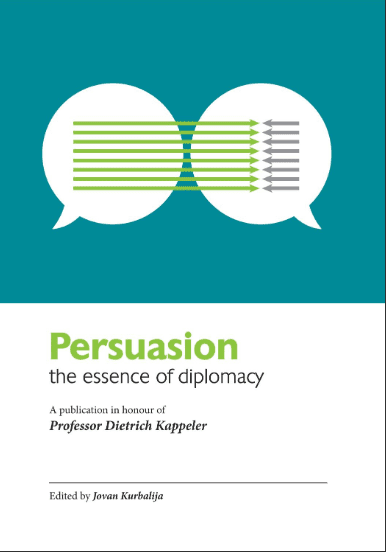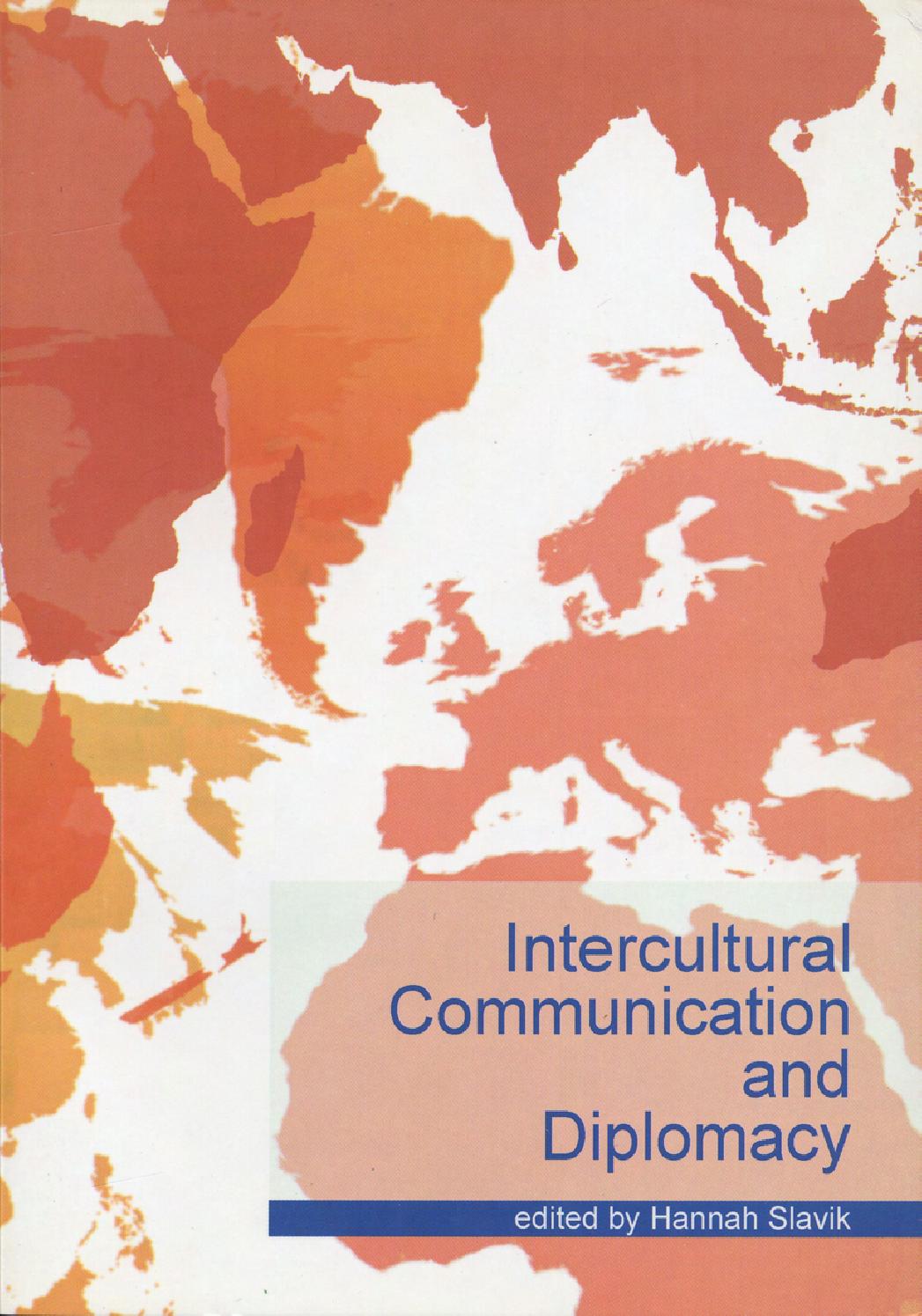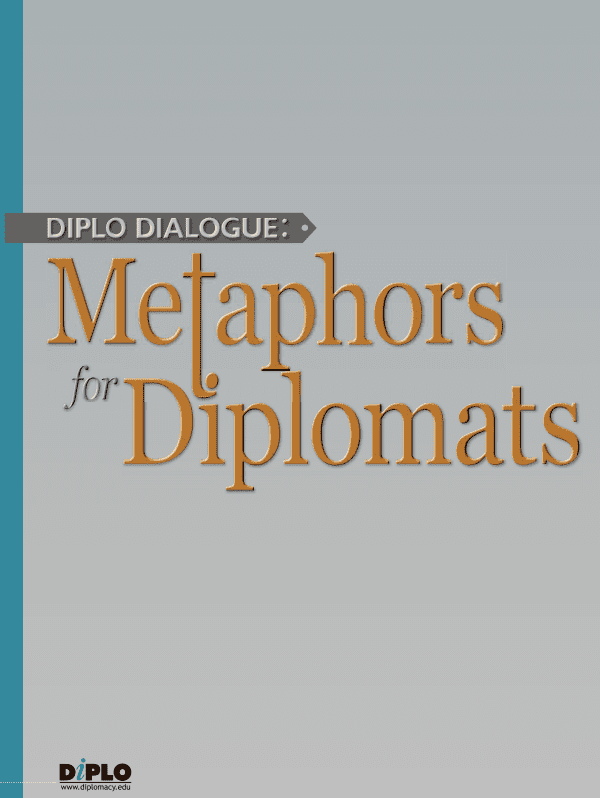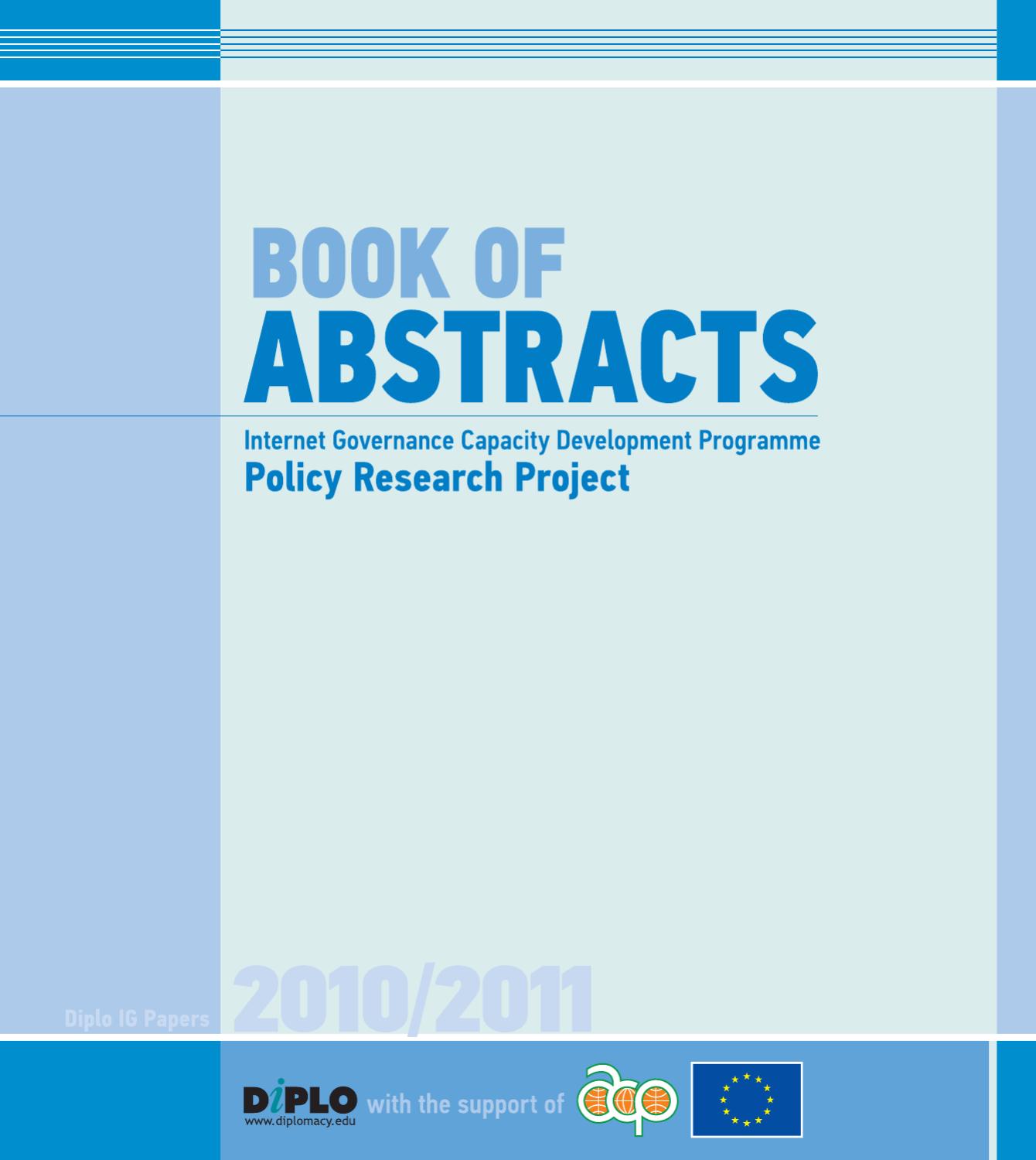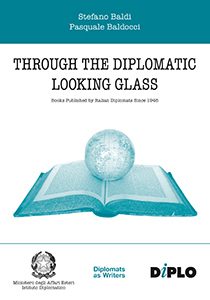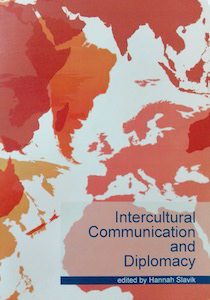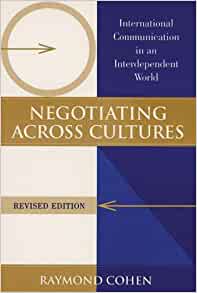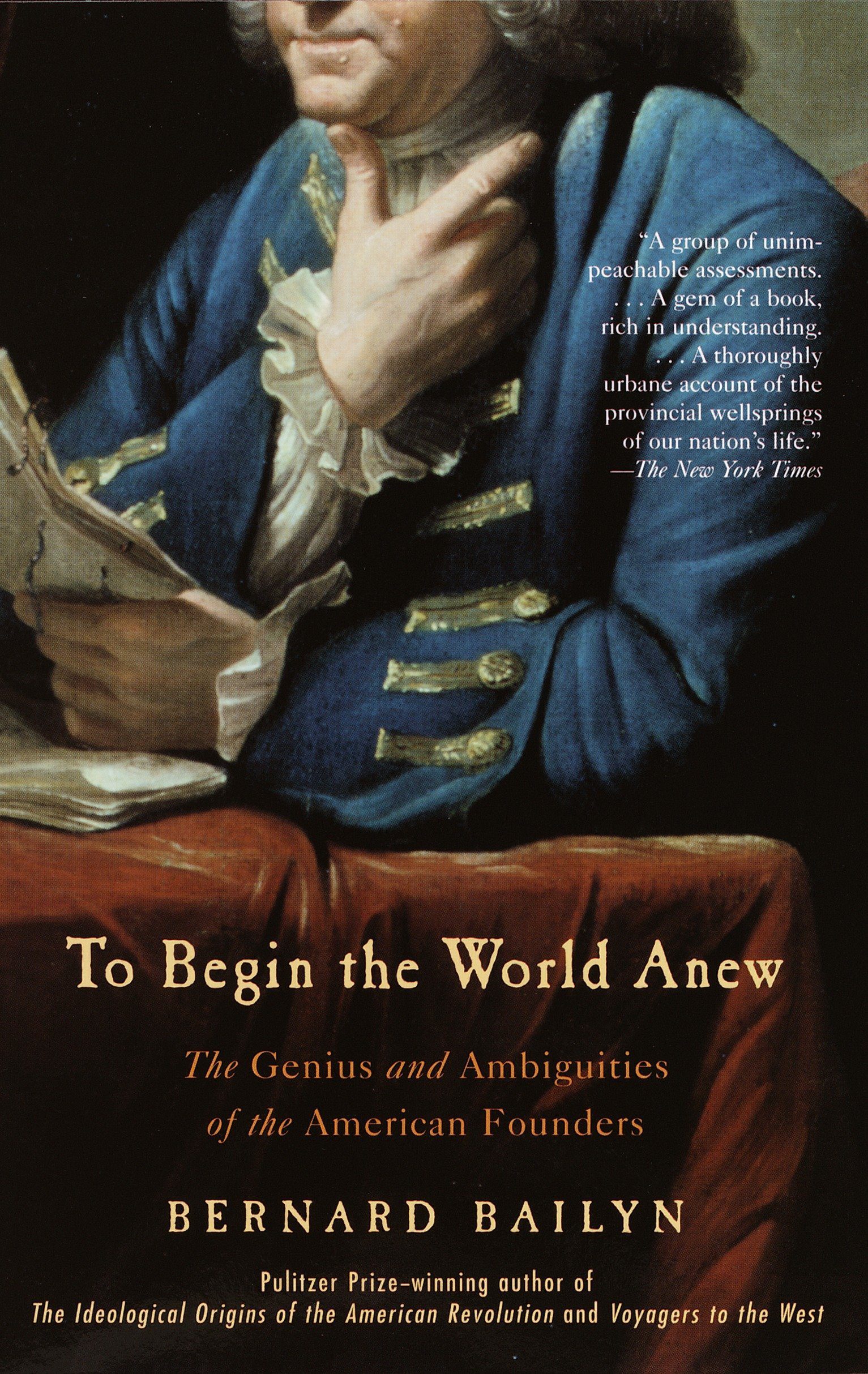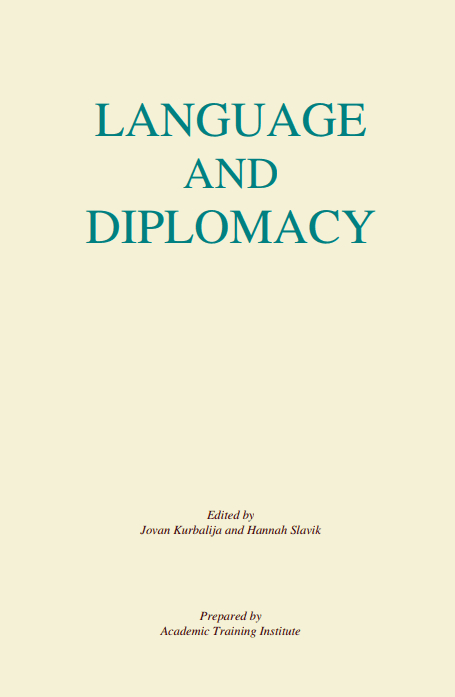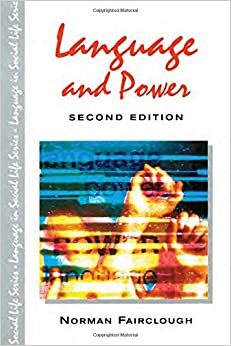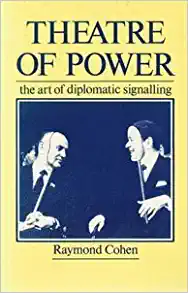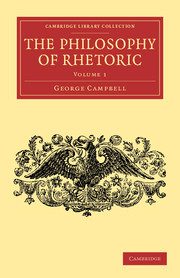We are here to speak about language.
The statement just uttered should be inoffensive. It is, after all, a truism. All of the participants during this session of the conference are here to speak about language. If diplomacy in that statement is elided, it is in reflection of the fact that we can all agree, without the need for any diplomatic effort whatsoever, that language will today provide a focus for us. This initial moment of agreement will have been precious, for we suspect that what we shall proceed to argue from it may prove sufficiently contentious to compel the re-inscription of diplomacy.
Let us, however, relish this moment of agreement a little longer, in order to make a few points which are uncontroversial but which will nevertheless instigate a need, later, for the re-citation of diplomacy:
We can expect that some of us at this conference will be pragmatic, and will offer ideas on how to manage, package, and massage language until the idiom of diplomatic documents is rendered judiciously transparent wherever the interests of diplomatic negotiation demand that it be so, and judiciously opaque wherever the achievement and survivability of diplomatic consensus – however uneasily that consensus is securable – is at stake.
Some of us will look at how contemporary developments in information technology can facilitate the processing of language and assist particularly in the linguistic analysis of diplomatic documents. This is a forte and a speciality of the Mediterranean Academy of Diplomatic Studies, and that which is so pioneeringly and uniquely its own should rightly be on display on an occasion like the present one.
Some of us will conduct linguistic analysis of diplomatic documents, and attempt to lay bare the fastidious subtlety of the strategies behind the composition of treatises and the multivalent considerations and political sensitivities which often impinge upon the drafting and redrafting of key clauses.
Some of us will offer historical and anecdotal accounts of how an attention to the scripting of diplomatic language has helped to determine the course of international events.
The conference will see all this happening, and more.
These points are as inoffensive as our opening statement. More to the point: where do we fit in?
Neither of us is a professional diplomat, nor have we ever studied diplomacy. Both of us are specialists, instead, in the analysis of literary language and of the kind of cultural discourse which interests the humanities. This may hardly seem like a qualification which sets us up naturally to address an assembly of diplomats. It may be as well to explain how we fit in therefore, by first explaining what we shall not be doing.
We shall definitely not be considering anything on the lines, for instance, of reflecting that the events in even that most ethereal of William Shakespeare’s plays, A Midsummer Night’s Dream, stem from the intrusion upon the spirit world of the implications of a most diplomatic wedding: that involving Theseus, Duke of Athens, and Hippolyta, Queen of the Amazons, who had earlier been at war with each other. This kind of reference, though significant in its suggestion of the irreducible role of diplomacy, is not quite appropriate to the terms of our invitation to this conference. That invitation originated on the basis of our presumed expertise in deconstruction, a critical discourse which has been applied to disciplines as diverse as law, architecture, and theology, but which in the minds of many remains associated with a very intense scrutiny of the language and assumptions sustaining literary and philosophical texts. If we fit in at this conference, then, it is on the basis of the assumption that deconstruction has something to contribute to the study of diplomacy and of diplomatic language, and on the strength of the expectation that we are able to point out what that contribution might be.
In the light of this, it should be made clear at the outset that there is no such thing as a “consultant deconstructionist”. If there is a hole in the market for such a position we remain, much to the dismay of our respective bank managers, unaware of it. What will be offered here, therefore, is not an analysis of diplomatic language founded on a protocol of methods which would be identifiably “deconstructionist”. We are here not to conduct a textbook deconstruction – although we do try to indicate, later in this presentation, how such a practice might proceed – but to offer some suggestions on how deconstructionist perspectives on language can compel diplomats to look more penetratingly at the language they produce and work with.
Those of you present who know something about deconstruction, and about the philosophy of language to which it is affiliated – poststructuralism – may look upon this program with some apprehension. They may fear for the integrity, after deconstruction, of diplomatic language. This is because they know that wherever the discourse of deconstruction irrupts, it does so parasitically. The discourse of deconstruction typically conducts itself by inhabiting the text it reads. One of the ways by which deconstruction works is by attaching itself to the analysed text so resiliently that there eventually arises a moment of near-symbiosis with the text analysed, until the discourse of deconstruction and the discourse of the analysed text are not easily separable. This is achieved by deconstruction working alongside the suppositions and the drift of the argument in the analysed text. It does so in order to tease out the occasionally disguised, occasionally self-evident strategies which underpin the argument. This teasing out of a text’s foundational rhetorical strategies is of course not a unique feature of deconstruction. Such a work of interpretation is not foreclosed to other approaches borrowed from linguistic and literary analysis, like stylistics or discourse analysis. Deconstruction differs from these approaches, however, because it works best when it places under scrutiny the apparent naturalness of the constituting presuppositions in an argument. It forces the silence with which those presuppositions are assumed1 into eloquent and self-critical self-exhibition:
Above all, deconstruction works to undo the idea that reason can somehow dispense with language and arrive at a pure, self-authenticating truth or method. Though philosophy strives to efface its textual or “written” character, the signs of that struggle are there to be read in its blind-spots of metaphor and other rhetorical strategies [emphasis added].2
Deconstruction tends, therefore, to force the discipline to which it applies itself to look at its own language and to develop an almost pathological awareness of its own linguistic strategies.
In congruence with this, a deconstruction of diplomatic language will tend to undo diplomatic language. There is a double sense of the word undo at work here. Diplomatic language is undone because it is unravelled until its strategies are loosened. It is also undone because by being so intensely scrutinised, diplomatic language ends up critiqued to the point of being made to stare – and this is undiplomatically over-emphatic – at the possibility of its own ruin.3
If that is the case, some of you may feel themselves wishing that we had, after all, stuck with Shakespeare. That would certainly have made us more popular on the conference floor. But we shall proceed with what we were commissioned to do, mindful that there is a point, later in this paper, where this presentation will demonstrate that it will not have been so undiplomatic after all. The integrity of diplomatic language will have been safeguarded.
While that is maturing, some of you will no doubt be thinking that all of the above has been a lengthy preamble to the task promised in this paper: a demonstration of what deconstruction can (un)do with diplomatic language. Deconstruction, indeed, typically set out by querying its frame, i.e. the context within which it finds itself.4 To that extent, this has thus far actually been a textbook opening to a deconstructionist analysis. By asking ourselves, in your presence, what justifies our participation here, we have foregrounded the fact that we are here almost parasitically, because we are about to explain how a particular discourse – deconstruction – can enter into a parasitic relation with the language to which it will here be applying itself: that of diplomacy.
We are therefore, to all intents and purposes, taking up the role of agents provocateurs. The agent provocateur is a figure who infiltrates a group in order to undo it from within. We too are acting like agents provocateurs: in our case by infiltrating deconstruction into this conference in order to undo the language of diplomacy. By applying deconstruction to the language of diplomacy, there will be insinuated into the event of this conference a doubled principle of parasitism, as we shall explain, and the relations of guest and host will thereby be transgressed.
Why do we so shamelessly and audaciously bring this to your notice? Could anything be more undiplomatic?
And yet: could anything be more diplomatic? Could we have done anything more compliant with the logic of the institution of diplomacy?
Let us remember that a host is somebody who welcomes, who offers hospitality, who holds the door of his dwelling open and bids the one outside to enter. The one who enters may comply with the rules of the house while inhabiting it, or may choose to make herself persona non grata by disregarding them. Is not this – by way of combining the protocols of deconstruction with the institution of diplomacy – the great opportunity but also the great risk run by a text subjected to deconstruction or by a country observing the rights of diplomatic personnel? Like a deconstructionist reading which can either reinforce or sap away at the text it inhabits, the practice of diplomacy can strengthen or undermine the country within which it conducts itself.5
To explain further: a diplomat resides in a host country conditionally. A diplomat is suffered to reside in a host country on condition that s/he respects the laws of that country and those governing the practices of diplomatic travel and exchange, and until such a time as that respect is no longer accorded or – for this can also happen – no longer reciprocated by the host. In this regard, there is an intriguing congruence between what the discourse of deconstruction sets out to do – i.e. inhabit the host text to work from within it, occasionally with it (in co-operation with it) and occasionally against it (in opposition to its foundational presumptions and idiom) – and what the diplomat resident in a host country does, i.e. liaise within the host country with its diplomatic and political class in the interest of securing further cordial exchanges between the respective countries, or as a privileged exponent of the discord which threatens to undermine mutuality between the two countries. It is almost as if the logic governing deconstruction is the logic governing diplomatic behaviour.
That is no doubt an overstatement.6 There is nevertheless enough of a resemblance in the two protocols to lend a certain piquancy to the fact that the particular application of deconstruction which will proceed over the rest of this paper will seek to undo the language of diplomacy, for squaring off one discourse against the other is bound to lead to a certain play of specularity and counter-identification.
Indeed: what does it mean to apply one bivalent discourse to another bivalent discourse? What happens when deconstruction, which when it inhabits a text can end up non grata,7 inhabits the language of a discipline – diplomacy – which when it breaks down can sometimes lead to those who speak it becoming persona non grata? And what happens particularly when deconstruction, which is wary of any recourse to the nomological – Derrida, for instance, speaks of his distaste for the phrase il faut (one must)8 – applies itself to a diplomatic text which, in order to prevent the very possibility of those it binds becoming persona non grata, seeks to lay down the law of the conduct of diplomacy?
It is to examine these questions that we have chosen to analyse, as our primary text, one of the foundational texts of diplomacy. The text we have chosen seeks, precisely, to regulate the parasitism which potentially undermines diplomacy, and to force upon it a certain probity and a protocol of acceptable behaviour. We are going to read with you, and ponder deconstructively, certain expressions in the “Vienna Convention of Diplomatic Relations”. The discourse of deconstruction, which is the discourse suffered to be parasitic on its host, will hereby seek to scrutinise a text which seeks to regulate diplomatic relations and to prevent them from becoming parasitic. There is, we think you will agree, a pleasing piquancy in this mise en abîme structure which takes the codified prevention of parasitism upon a host and embeds it within an approach which is parasitically made to inhabit that very codification.
*
The Vienna Convention on Diplomatic Relations dates back to 1961. Manuals of diplomacy tend to speak of it as a watershed document whose “scope and success” are “impressive”. It is, we are told, “almost universally regarded as embodying international legal rules on diplomatic intercourse between States”. The document is all the more significant because “[i]ts gestation (1956-59)…was attended by considerable goodwill and co-operation and a good deal of hard work”, and because it emerged from “an almost unique impetus towards international accord”.9 There is here a repetition of almost, to the significance of which we will need to return. The Convention, we are assured in the meantime, “has been accepted by an overwhelming majority of the members of the United Nations as representing an internationally agreed codification of modern diplomatic law”.10
We would like to read with you this Convention, this law of diplomacy. We are particularly interested in the procedures of the “internationally agreed codification” of this law. These procedures which institute the Convention as law, and arraign to themselves the legitimacy that finds it foundation in “international accord”, inaugurate, in the moment of description of the practice of diplomacy which is also a moment of prescription, the forthcoming relations between the history and the law of diplomacy. The history of diplomacy should henceforth be circumscribed by the law of the Convention, at least to the extent that the practice of diplomacy after 1961 approximates to, rather than deviates from, the law.
Let us not underestimate the linguistic complexity that must convey the significance of this contract. By the rules of the language we speak, when two or more sides convene they come together. This happens even more fatefully when out of the coming together of States, a law is instituted which is itself a product of and a crowning achievement in the history of the diplomatic intercourse between the nations of the world. What else can we anticipate of the event save that it makes history and that it takes place under the roof of language?
The procedures which proclaim and seal this event foreground themselves in the Convention’s beginning and end. We would like to read with you, therefore, the Convention’s preamble and the last of its articles, Article 53, which both appear to us particularly aware that the eventfulness of the occasion needs to mark itself with its own momentousness and declare its own status as law. Indeed, it seems that we are looking at a text whose logic, born out of “international accord”, is irreproachable. The portentousness of legalese – a portentousness to which “the States party to the present Convention” (and we have been reassured that they form the “overwhelming majority” of the United Nations) are in turn party – monumentalises the probity of that logic. The Convention, in its very beginning, feeds itself with its own authority, defines itself in its own terms, guarantees its own authenticity. It is a text that disqualifies but does not qualify what is external to it.
There is no higher law, no law more authentic than the one that is utterly closed to the outside. So it seems, but we would not really have you believe that.
The question of a text’s authenticity is indissolubly linked with the problem of determining its limits, and it is almost superfluous to add that a text like the one under study, so neat, so self-possessed and self-contained, will have done the job for us in advance. There is no way we can hope to break in, and perhaps (prospect more hopeless still) we are in there already. But for one important complication. We come upon it, significantly, in the document’s opening paragraph, in an intractable phrase situated at the text’s margin, and presenting us with our very first gate of entry.
The first words of the opening sentence of the Convention reads: “The State parties to the present Convention have agreed as follows”. Never mind that these words do not make up a complete sentence. What’s more important, for the purpose of our investigation, is that the sentence comes with a parenthesis, and a long one for that matter, which splits its syntax in two, distancing further than we can take hold of in a single breath or in a single grasp of memory Subject (“The State parties to the present…”) and Predicate (“have agreed”). It is a separation that will, among other things, perform an interesting game with time, freezing in a timeless present of memory (“Recalling…”), belief (“Believing…”) and assertion (“Affirming”) all the operations by which the present perfect of consensus (“the States…have agreed”) will contract the future to that which is diplomatically legalised in the moment of the utterance of diplomacy’s law.
But let us not stop on that for the moment, or not yet. Let us look, instead, at that part of the Convention’s opening sentence (which does not wind to a full-stop until the end of Article 1, by which time definitions have been established) containing the parenthesis:
The States parties to the present Convention, / Recalling that peoples of all nations from ancient times have recognized the status of diplomatic agents, / Having in mind the purposes and principles of the Charter of the United / Nations concerning the sovereign equality of States, the maintenance of international peace and security, and the promotion of friendly relations among nations, / Believing that an international convention on Diplomatic intercourse, privileges and immunities would contribute to the development of friendly relations among nations irrespective of their differing constitutional and social systems, / Realizing that the purpose of such privileges and immunities is not to benefit individuals but to ensure the efficient performance of the functions of diplomatic missions as representing States, / Affirming that the rules of customary international law should continue to govern questions not expressly regulated by the provision of the present Convention / Have agreed…
Perhaps what is most unbalancing about this parenthesis is the suggestion, propounded in the first few lines, that the States engage in an act of memory (“Recalling…”). They have, indeed, a memory in common, pertaining to what diplomacy has been “since ancient times” and one which makes it possible to say that the States are “of one mind”. If we can say of this memory that it signs the text, if the one mind is seen to exist as the Convention’s basis, frame and limit, then the identity of the text has been problematised already, and that in the very assurance of its self-possession.
It is surely not insignificant that for a long time the meaning of diplomacy was synonymous with archivisation.11 A diplomatic oneness of mind with a memory and a reading library would know in advance the nature of that which cannot be spoken of in the record of the coming together, at Vienna, of an “overwhelming majority” of States within the United Nations. That which refuses the invitation to convene to come together and commune, and to archive this moment of law as law, is that which in the accord (born from States being of one mind) establishes discord as that which refuses to sign the Convention (which is also an archive of a consensual convening). It is also that which must be repressed at the moment of the law’s self-proclamation.
There is enough, here, for the text of the Convention to have had its self-confidence (a confidence, also, in the promise of its impenetrability and generalisability) shaken. A History and an identity that remembers and safeguards this History, among others archivising it in the text of the Convention, have appropriated the law.
But the law binds only those who sign. And it is indeed in the motif of the signature that this deconstructive reading will find its pre-text.
It is among the objectives of this deconstructive exercise to focus on the Convention’s attempts to master and define its own identity. The mastery appears practically flawless, but it can be seen to belie itself. We will attempt a reflection on how the Convention’s rhetorical strategies involve it, and its signatories, in an ideological paradox that it would probably shy away from, chary of the politics of property and appropriation that guarantees the law, and the law alone, an access to its own identity.
Yet the issue of property and appropriation is, of course, where it all coheres. We read, in the Convention:
Article 29.
The person of a diplomatic agent shall be inviolable. He shall not be liable to any form of arrest or detention. The receiving state shall treat him with due respect and shall take all appropriate steps to prevent any attack on his person, freedom or dignity.
Article 30.
1. The private residence of a diplomatic agent shall enjoy the same inviolability and protection as the premises of the mission.
2. His papers, correspondence and, except as provided in paragraph 3 of article 31, his property, shall likewise enjoy inviolability.
Dare we see this as an allegory of sorts?
Can we resist the temptation of assimilating it and its governing concepts into a reading practice, that promises in fact to betray it completely?
Contemporary myths of language, particularly those affiliated to the “linguistic turn” in the humanities, have accustomed us to suspect of concepts concerning mediation, the proper and the law. In particular the dream of a neutral language, a language super partes which would be untouched by other languages between which it is called to mediate, is one upon which incredulity falls. Such a neutral language, politically measured, corrected of all possible double entendres, neutered of any association that is foreign to the business of law, unvitiated by implication and which exists only in what it means to say, represents a challenge to Institutions of Diplomatic Science and what they might wish to prescribe and proscribe. The language of the diplomat, but not only his, must make up its mind on whether it can still be a language open to mediation – and let this word be qualified by its etymological kinship with healing – or whether it will affirm its unassailable neutrality, its being in between two sides, its being always mediated, that is to say always already immune.
While it tries to make up its mind, let it hear what the myths spell out:
As distinguished from a litigation, a differend [différend] would be a case of conflict, between at least two parties, that cannot be equitably resolved for lack of a rule of judgment applicable to both arguments. One side’s legitimacy does not imply the other’s lack of legitimacy. However, applying a single rule of judgment would wrong (at least) one of them (and both of them if neither side admits this rule).12
A myth, this, with a suggestive applicability to the impasses which diplomacy sometimes encounters. There is then, no language that is metalinguistic. That is a drama explored in the theory of poststructuralism, but it is also the drama lived by diplomacy. In practice, and however many languages the diplomat knows, the diplomat can only ever inhabit the dimensions of language that are bound to the immediacy and the dictates of circumstances beyond which no other or higher propriety can be accessible, while yet pretending that the possibility of the meta plane, to which the moment of mediation would properly belong, exists. Is not this the fiction and the site in which the Convention is written? But if there is always, only, a differend, then what is it that is proper to the Convention, merely?
To explain otherwise: the language of the diplomat, the Convention appears to affirm, possesses a memory of its own, and consequent upon that property is a responsibility unto history. That responsibility is ideologically charged, at least in respect of the ideology of language which it silently embraces. It is an ideology which renders it possible for the Convention to speak as from a place where full possession of its own speech can be claimed, and where it is unproblematically authentic to itself. This allows the Convention to inaugurate, in an act of illocution, what it does. The act is tantamount to the inauguration of a metalanguage, or “a rule of judgment”, to which supposedly no differend would be intractable. And yet, truthfully – for a text, as deconstruction holds, cannot lie about itself even while it dissembles and gambles with self-disclosure and self-concealment – the Vienna Convention raises the question of how authentic its speech can ever be in laying claim to the status of “a rule of judgment”.
Authenticity, let us remember, is a matter which both concerns the law (and, more precisely, the law of property) and the issue of identity. The issue of property is what determines the Convention’s memory and guarantees the identity of that memory, such that the Convention may always be identical to itself irrespective of who lays claim, in whatever language, to its letter.
The question of the Convention’s authenticity may thus be rephrased:
Who owns the text, or whom does this text own? Who is supposed to own this text, or whom is it supposed to own?
And also, and not least, who will own to this text?
Let us, in an attempt at an answer, look for the word authentic in the text. We find it at the end of the Convention, there where the issue of language, and thereby that of property and identity, is uppermost:
The original of the present Convention, of which the Chinese, English, French, Russian and Spanish texts are equally authentic,…
You will doubtless guess why this sequence was chosen. It is intuitive, is it not, that the “equally authentic” character of five different languages is a chimerical entity. Admittedly, there is a pragmatic and a political advantage to be gained by assuming that all five languages are equally authentic, not least the fact that sensitivities concerning the relative importance of the five languages are not hurt. We understand this. The problem, however, is that language tends to undo confidence in the equivalence of different tongues and in their ability to congruently express similar sentiments. Indeed, the use of similar in the previous sentence indicates the problem, for similar effects are not good or precise enough in contexts like those which the Convention, in its multilingual forms, tries to regulate. Identical – returning us to the issue of identity and its link with authenticity – would be the adjective required, and the absoluteness of the identity at stake is suggestive of the problem. All the versions of the text, in all five languages, must be absolutely identical to each other. In none of the squarings off between the five versions of the Convention can a remainder or a lacuna of meaning be tolerated. Such a remainder or lacuna could lead to diplomatic embarrassment or, in that well-known and fateful euphemism, to a “diplomatic incident”.
Now to believe that avoidance of a remainder or a lacuna of meaning is possible is to believe in the interchangeability of languages and to ignore problems of translation and of what can be lost in translation. It is also to disregard the fact that effects of ambiguity, nuancing and connotation, some of them perhaps unwitting, will indubitably take over to erode the integrity of the Convention’s identity once it finds itself expressed in more than one language.
What can be said about this, except that it forces us to rethink the text’s canonicity? When a text attempts to be canonical, when it is conceived to speak the law, it tries to disclose its own impregnability. Even if it were found to have errors and loopholes, the fault couldn’t be hailed but as a hallowed guilt, itself enshrined in the law which the text speaks and is. Such a text cannot be disqualified even if it is disqualified by its own language. To challenge the authority of its word would be to challenge the law. That would also be to think the unthinkable: the unthinkable of the challenging of the law, from which the history that the law would bind could then ensue unregulatedly.
It follows almost logically, therefore, that the text must declare and legitimise its own authenticity. And it is singular indeed that it must do this in the very same breath as it affirms its status of equal authenticity in Chinese, English, French, Russian and Spanish. The possibility of equal authenticity is, subversively, also the possibility of unequal authenticity.
The text’s greatest embarrassment lies here, in its language, and at that point where it declares its own authenticity – its self-possession and self-identity – in different languages, the multiplication of which speaks a plurality of histories as well as a plurality of tongues. Over those histories, and those languages, no metalanguage can mediate, either arbitratingly or healingly – at least if certain poststructuralist views of language are to believed.
Why is it that the Vienna Convention on Diplomatic Relations, even to a reader unversed in deconstruction (for few readers would really take the claim of equal authenticity at face value) reveals a disconcertingly high confidence in the transparence of language, and in language’s capacity to be unproblematically referential, perspicuous, and denotative? Why does it appear to affect a disingenuous innocence in language’s capacity to possess and identify what it wants to say? Why is it that it seems to believe in language’s own authenticity, upon which another authenticity – that of diplomacy – would rest?
Need we really ask, except to anticipate that the answer will say as much about the language of deconstruction – which tends to suspect the affectation of transparence and perspicuousness – as it does about the language of diplomacy – which often needs to contrive to be both affirmative and non-committal? This incommensurability between the ethos of the two discourses will, as we will explain, ensure that neither emerges unscathed from the encounter with the other.
Let us first, however, read on a little further, and see what follows the assurance in the Convention of equal authenticity. We read that the Convention “shall be deposited with the Secretary General of the United Nations, who shall send certified copies thereof to all States belonging to any of the four categories mentioned in article 48”. This is taken from the sentence which concludes, just before the signatures which ratify the Convention and to whose problematic nature we will need to return,13 the Convention. And article 48, to which the above sentence refers and appeals, reads:
The present Convention shall be open for signature by all States Members of the United Nations or of any of the specialized agents or Parties to the Statute of the International Court of Justice, and by any other State invited by the General Assembly of the United Nations to become a party to the Convention as follows: until 31 October 1961 at the Federal Ministry of Affairs for Austria and subsequently, until 31 March 1962, at the United Nations Headquarters in New York.
The law, then, circumscribes itself through the imperativeness of deadlines. “Sign me by such a time,” it says, “and you will bind me to come into being, to bind you with the law of the past and future history of diplomacy”; “fail to sign me before the allotted time, and you will not be bound by me, nor will you bind me”. The Convention at Vienna, then, or its text, will not have been the last word. There is yet time, until 31 March 1962, in which one can sign in order to submit to but also to birth the letter of the law of diplomacy.
It was never going to be, simply, a matter of simply ratifying the Convention. There is also and necessarily time in which to refuse what the Convention attempts to lay down as law, and the time for that refusal is written into the text, which thereby inscribes within itself the possibility that unless it is signed it would be pregnant only with the promise of its lawfulness.
There is a strange temporality at work here. The Convention, written throughout in a play of tenses which appears to assert that it is already binding and settled (it is written, in the preamble, that “The States parties to the present Convention…have agreed”, and in the conclusion that “the undersigned plenipotentiaries, being authorised thereto by their respective governments, have signed the present Convention”) actually defers to the tyranny of a future of signatures: signatures which can be forthcoming or withheld.
Nor will the future unfold itself unstintingly. The Convention, when signed, will have been ratified by the States in whose name representing diplomats will have come to sign. There will have been a period of waiting, in the hope that more proxies – for self-presence was never on the cards, it was always going to be a game of deferrals and relays – would put their names to the document. And then, at the deadline, when it would have been clear that no one was going to come to sign any more, even if there remained space if not time, then the Convention would have been bound: bound into being; bound by those who signed and who it in turn binds to itself as to the law; but bound also, and perhaps above all, by those who chose not to turn up in time to sign, and who it therefore does not bind nor is bound by.
Thus will have been accepted, or refused, the time of an inauguration of a law of diplomacy which would also be the time of the rememoration, archivisation, and contracting of a history of diplomacy.
And the temporality is all the stranger because it is forcing us, here, now, to speak of the Viennese past of March 1962 in tenses which seem inappropriate, which seem to merge past, present and future in a oneness of time which is unrealistic and is yet the realtime of diplomacy, at least since March 1962.
And what if one does not sign in time (we can indeed, keep to the tense of realtime, the present) or withholds the signature? Is not this, as well, written in the Convention? Is it not this, ultimately, that is the trouble? Have we not said above, already, that the text of the Convention disqualifies what it excludes, that the text is closed to its outside, that the play of almost in so many sentences extolling the near-unanimity of parties to the Convention is significant, that the law of diplomacy can henceforth be approximated to or deviated from? So many different ways of defining the inside and the outside of the Convention, or what is proper to it and what is not. So many different ways of approaching, to re-cite other questions we have asked, the issue of who owns the Convention, whom it owns, and, most of all, who owns to it.
In the event, we know that the majority of the United Nations’ member states did sign. The majority of the peoples of the world owned to it, signing it through the proxies (or diplomats) of the proxies (or governments) of the people. Strange, indeed, that the law must be instituted by the proxy of the proxy of an authority which derives from the people, who are ultimately of little account, as is marked by their metonymic representation through the word States.
We do not want to known – or need to know – which States did not sign, and why. It is enough to know that unanimity was not absolute. One state would have been enough, according to the logic of exemplarity which deconstruction has shown to be the logic of universality,14 that it was always possible not to sign. We also need to remember that in the realtime of diplomacy one does not sign the convention once only, but recurrently. A state is always ratifying or not ratifying the Vienna Convention, through its adherence or non-adherence to the law of diplomacy.
A pariah state which does not sign, which places itself outside the practice of diplomatic law – like the country where the iconic figure of deconstruction was born: please allow us this allusion rather than an identification of what is, in any case, well known already15 – represents the outside of the law of diplomacy, over which the law can pronounce only its reproach. For the law in question can seek to bind only those who agree, recurrently, to be bound. Those who remain outside the jurisdiction of diplomacy are those who are excluded from the law of the Convention. And those who remain outside, who refuse to sign, are precisely those with whom a process of translation is most urgent.
Was there not always going to have to be a process of translation? Who is it that is not covered by Chinese, French, English, Russian and Spanish? All those who do not answer to those languages, who do not own to them and who yet would like to own to and answer to the Convention, must translate or be translated in binding themselves to the law of diplomacy. Yet is there not also a political violence in this privileging of five languages which, though they cover the majority of the world’s population, commits all the others who do not speak one of them to a necessary exercise of translation? If there is going to have to be translation, is authenticity assured? Do we really believe that it is?
You will perhaps tell us that one need not be a deconstructionist to build up distrust in certain expressions of the Vienna Convention and in its deliberately disingenuous faith in language’s perspicuity. That is true. We agree. But one perhaps does need deconstruction to insist on making eloquent what the Convention silently suppresses. Deconstruction can only uncover what is in the text already, what the law of diplomacy has written while writing itself and its knowledge of itself: a knowledge which dissembles. To us, indeed, the critical question is the following: if diplomacy knows about itself, already, what deconstruction reveals through a reading of a law of diplomacy, then what is it that hangs in the balance when deconstruction makes that knowledge explicit? Is it merely, and crassly, the exposure of a certain “bad faith” of diplomacy, which diplomats might in any case present as necessitated and as marking, in a strange paradox, the best of intentions? Should not the phrases we have already cited reassure us: “[The Convention’s] gestation (1956-59)…was attended by considerable goodwill and co-operation and a good deal of hard work”, and emerged from “an almost unique impetus towards international accord”?16
Let us not forget, as a preliminary to our attempt at a reply, that nurturing the stock idea of a diplomat is the perception of a person who is fluent in more than one language, and of one who is allowed to reside in and move between countries with a certain facility and in enjoyment of certain privileges. The diplomat, then, is a person who can move between languages and between states. S/he is, indeed, a person who by definition moves between different states of language. S/he is a figure who makes a dwelling in different political and linguistic states. Such a figure must be linguistically sophisticated, and quite as sophisticated as the language of deconstruction which, if it holds itself to any precept at all, binds itself to the imperative which derives from the emblematic French phrase plus d’un langue: “more than one language”, but also “no more of one language”.
Deconstructionist texts often work precisely through exploiting and deploying the connotative resources of more than one language. To a deconstructionist sensibility, indeed, there are probably few things quainter than the prospect of a multi-national assembly of diplomats twiddling their simultaneous translation sets to receive a flow of instantaneously translated languages. The assumption which makes simultaneous translation possible is that languages can unproblematically and totalisingly denote meaning in a one to one relationship with each other and with that which they purportedly designate. Coupled to this is a further assumption, namely that meaning is never compromised by being expressed in a language other to that within which it was originally uttered.
If diplomats are themselves so sophisticated, why is their sophistication so frequently suspended? The example we have just cited – diplomats’ recourse to simultaneous translation – suggests to us a strategic suspension of their intuition of the complexity of language. For indeed, of diplomats’ linguistic sophistication we have no doubt. We are sure that a number of participants at this conference will have anecdotal accounts of the trouble taken over the drafting into a document of a single word or phrase. Diplomats know only too well, at first hand and very often in all too direct a knowledge of the stakes, what can hang on the political and diplomatic class securing agreement over a sticking point whose dimension can be verbal as much as political.
No greater indication of diplomats’ sophistication can be given than was given to us by the members of the Academy organising this conference. We will not be embarrassing them if we say this. When we first read the text of the Vienna Convention it was in an electronic format, the existence of which they generously pointed out to us. The format can be downloaded from a website, where the text of the Convention is subjected to linguistic analysis by the staff and students at the academy. On this electronic text one can find at various points, in the form of question marks and open books (the icons chosen are not insignificant), cues to other web pages, where the ambiguity of diplomatic language – that same ambiguity whose presence “in `international relations’ is not to be imputed”, according to Raymond Aron, “to the inadequacy of our concepts”, but to “an integral part of reality itself” 17- is pursued.
The question therefore restates itself: if the language of diplomacy is so sophisticated, and if diplomats are so aware of ambiguity and of the way in which language undoes itself, why does it appear that diplomacy appears sometimes so blind to the complexly elusive nature of language? Or is it, as all of us here know (let us not be coy), that diplomacy necessarily has to engage on occasion in a strategic suspension of its linguistic sophistication? In this respect, is it not significant that while the rest of the electronic text is tagged with question marks and open books, there is no icon at all to be found in the space stretching between the fateful Article 48 and the end of the text?
To spell things out: is it not significant that the absence of glosses is most visible where the text’s presumed blindness to its own vulnerably sustaining strategies is glossed over by the professional diplomat? If one answers in the affirmative, it is assumed that the analysis of the document’s rhetorical strategies can provide the reader with the most attendable testimony to the ideologies that govern and purpose its History. The question we’d like to ask, we would naturally want to ask language; but language, in the game of self-disclosure it plays, could make only a parody of its true self in its response. It is a given of poststructuralist myth that language signs as its own ghost-writer. Let us then agree that in order to interrogate the text itself as to the truth of this same assumption it is advisable to attend to its unstrategic silences, rather than to the strategy of what it states. And would not this be the role of deconstruction: bringing forth to visibility what diplomacy finds most discomfitingly deconstituting about itself, and thereby making all the more important in the tension arising from that exposure (as we suspected, you will recall, in the beginning of the paper), the re-inscription of diplomacy?
It is all very well for you, you will probably tell us in response. We live in the real world, you will say, where decisions have to be taken, where diplomats’ responsibility to language must be sacrificed to their responsibility to history. We understand, and we sympathise. The immediate pressures of a diplomatic crisis, away from the safety of conferences, have to be resolved through a use of language which is measured to the situation in hand. The law of the language of diplomacy, above all, has to regulate what in reality passes under the name of diplomacy. The difference between diplomacy and deconstruction, then, is the difference between practice and theory: between the constraints faced and smoothed by the pragmatist and the aporias agonised over by the philosopher (let us not forget that, among other things, deconstruction represents to some extent a philosophy of language).
Again, we agree. But that is not all. We are not so sure that the responsibilities to history and to language are so easily divorced. We shall give only one example in support of this view, and that will concern the issue of persona non grata, of the diplomatic personnel who, because they fail to abide by the law of diplomacy (or because the receiving State fails to), end up expelled or refused entry by the receiving State. Such people find themselves outside the law of the Convention. Here, in confirmation, is the Convention’s Article 9:
The receiving State may at any time and without having to explain its decision, notify the sending State that the head of the mission or any member of the diplomatic staff of the mission is persona non grata or that any member of the staff of the mission is not acceptable. In any such case, the sending State shall, as appropriate, either recall the person concerned or terminate his functions with the mission. A person may be declared non grata or not acceptable before arriving in the territory of the receiving State.
This, of course, would spell the defeat of what the Convention seeks to regulate. By definition, it places itself outside the Convention. The Convention therefore internalises the possibility of its outside, and of the unpredictability and unaccountability of that outside: “at any time and without having to explain its decision”.
The outside need not be explained then, nor need it be phrased within language.
But what of that instance of history – and language – which might seek cover under the roof of the diplomatic language of the Convention, from the outside, however exceptional that instance may be? Deconstruction, as the discourse of “the logic of parergonality” which is sceptical about the integrity of frames, of the integrity of the margins between inside and outside, will not be surprised that the Convention has no terms for what might seek to penetrate it. Here, in illustration, is a telling remark by a diplomat about the Convention’s incapacity to come to terms with its outside:
The inviolability of the premises of a diplomatic mission has traditionally rendered them liable to be sought as a place of refuge. The question of the existence and validity of this right of asylum from political persecution (it is not normally applicable in ordinary criminal cases) remains dormant for long periods, only to be the subject of acrimonious discussion from time to time. In Europe the practice is nearly extinct. It is a situation that can, in the end, be resolved only by negotiation, if only because the Vienna Convention on Diplomatic Relations, whilst ensuring the inviolability of the premises of a diplomatic mission (and thus of those within it) makes no provision for the departure under safe conduct of any person not covered by the Convention [emphasis added].18
The Convention (being that which preserves boundaries, which regulates the traversal of State upon State, but which paradoxically needs to believe that meaning is equivalent to itself and self-identical across languages) does not provide for what is outside it or for what might yet appeal to the law of diplomacy. The situation needs, in such a situation, another board of appeal – our source mentions, as a possibility, the Convention on Diplomatic Asylum drawn up by the Tenth Inter-American Conference of Caracas in 1954.19
This referral (which would also be a deferral) to a non-European situation is not accidental. Are we are not told also, by our source, that a situation like the one above is “nearly extinct” in Europe: as if that were reassuring, as if that keeps us in Europe as in the home of a perfectly well-ordered diplomacy. Is such sanguinity not misplaced?
Let us explain why such sanguinity in the terms of the Convention, and in the primacy of Europe’s ratification of those terms, is misplaced. We do that by enjoining you not to forget the determinism, in all this, which is exerted by the city of Vienna. Vienna is the city where the law of diplomacy under discussion was launched. It is, for diplomacy’s law, a home. Vienna is also, however, even as we speak and as you will know much more fully than we would presume to do, the city which places itself outside the oikos of diplomacy. It is presently one of the homes of diplomacy which is estranged from itself, which is estranging others, and which is estranged by others. History – we couldn’t agree with you more – always foists, unpredictably – for who could have seen this coming, or returning (is it not the prospect of a certain return of and from Europe’s past which is most worrying about all this?) – the outside of the law of diplomacy upon itself. Vienna, by placing itself outside the fold of diplomacy – let us not bandy words, for the moment, over “who started it”20 – forces the law of diplomacy, to which the city lends its name, to fold back upon itself and consider how the outside might irrupt on the apparently inviolable inside, and to do so in a manner which was always already possible, which was always already inscribed in the law of diplomacy and indeed in diplomacy itself. For does not diploun, the Greek word from which diplomacy is derived, script this in advance? Listen to the past of diplomacy, which continues to dictate its present and future, and which predisposes it, as we shall show, to the counter-identification with deconstruction:
[Diplomacy] is derived from the Greek verb “diploun” meaning “to fold.” In the days of the Roman Empire all passports, passes along imperial roads and way-bills were stamped on double metal plates, folded and sewn together in a particular manner. These metal passes were called “diplomas.” At a later date this word “diploma” was extended to cover other and less metallic official documents, especially those conferring privileges or embodying arrangements with foreign communities or tribes.21
There is a strange fatedness in all this. For diplomacy, the discourse of the fold, is here being undone by deconstruction, a discourse which has always, in ways too complex to rehearse here, insisted on the pli within language.22 Diplomacy and deconstruction: both are languages of the fold, which return upon themselves to undo themselves and each other in the game of counter-identification we have been pursuing all along. If, as we think, diplomacy is undone by deconstruction (by a discourse which can become non grata because, like an agent provocateur, it sometimes takes up residence within the spaces of the other’s discourse in order to subvert the poise of those spaces) it is because it is made to go back upon itself, and discover that what was its outside can always be made to turn upon the inside, that the outside – the unthinkable of diplomacy which the law seeks to expel or at least regulate – can always, as it has done at Vienna (the very home of diplomacy’s law) penetrate what was seemingly impregnable. Diplomacy’s undoing by deconstruction is therefore a folding of diplomacy upon itself, a forcing of diplomacy to understand that its greatest responsibility would lie in facing up, in the name of both practice and theory, to what it already knows when it affects not to know. Theory would, thereby, have shown practice what was in theory always possible: deconstruction, discounted as lacking in pragmatism because it is, by definition, theoretical, is always liable to return to haunt (diplomatic) practice with the threat of a possibility, hitherto thought merely theoretical, that suddenly becomes all too actual.
In the process, however, deconstruction is in no position to affect smugness, or an independence from diplomacy. Diplomacy is what once saved it in an all too pragmatic situation.23 Diplomacy is what it has crossed (in all senses of that word) when considering the monolingualism of that diplomatic other from whom, after all this, it must expect a response.24 Diplomacy, above all, is a discourse of folds and postal relays, of encounters with the alterity within language which threatens to compel the same moment of recognition and counter-recognition that deconstruction itself found in another discourse which found its home in Vienna: psychoanalysis.25 For Vienna, it is as well to recall, also witnessed the inauguration of the discipline of psychoanalysis. Psychoanalysis is based on the rememoration within speech of a past which continues to exert a dislocating influence upon the present: a discipline which discerns within the speaking subject’s division from itself the unrealisable desire of a wholeness that would be both originary and promised.26 It is fitting, we cannot help thinking, that diplomacy in its establishment of its law found itself at Vienna, and discovered in this geographical coincidence with psychoanalysis the illusion of a unitary and regulated wholeness. It forever discovers, there, that its being exceeds what the law foresees.
Psychoanalysis, like deconstruction, could have told it in advance that that might happen, and avant la lettre: before the letter of the law. The explanation of this relation of antecedence concerns time, and it is time which compels us to say that the explanation would need to be the subject of another conference, where in our consideration of these three discourses – diplomacy, deconstruction, and psychoanalysis, all uncannily centred on la politique de l’autruiche27 – we would not only have been speaking about language, diplomatically.
ENDNOTES
1. The ambiguity of the word assumed is significant. Assumed can mean to take as read and to take on; both meanings are in play here.
2. Christopher Norris, Deconstruction: Theory and Practice, rev. ed. (London: Routledge, 1991). To anticipate: what we will undertake to do in this paper is to indicate that the word philosophy in the quotation is substitutable by the word diplomacy. We would ask you, particularly, to attend in what follows to the echoes of “self-authenticating”, “blind-spots” and “rhetorical strategies”.
3. The sense of ruin is foregrounded in dictionary definitions of a second meaning of undo: see in particular the entry for undo in that definitive lexicographic arbiter, the Oxford English Dictionary.
4. Consider, as an extreme example of this, the following sentence in the first paragraph to a deconstructionist text: “I am addressing you, am I not?” – Jacques Derrida, Politics of Friendship, trans. George Collins (London: Verso, 1997), 1.
5. It might be objected that any mode of literary criticism can inhabit a text in this way. There is, however, a qualitative difference in deconstruction: one too complex to develop here, but which has to do with a play of citation peculiar to deconstruction – and therefore of speaking the language of the text in a manner analogous to that whereby diplomats speak the language of the place they professionally inhabit. Concerning the importance of citation as a deconstructionist resource, see Claudine Sartiliot, Citation and Modernity: Derrida, Joyce and Brecht (Norman and London: University of Oklahoma Press, 1993).
6. We shall not go so far, in imitation of a certain notorious statement within deconstruction which holds that “deconstruction is justice”, as to say that “deconstruction is diplomacy”.
7. For examples of how and why deconstruction is as much suspected as it is applauded, see Niall Lucy, Debating Derrida (Carlton: Melbourne University Press, 1995).
8. Jacques Derrida, “Between Brackets I,” in Points…: Interviews, 1974- 1994, ed. Elisabeth Weber, trans. Peggy Kamuf and others (Stanford: Stanford University Press, 1995), 19.
9. Charles J. Lewis, State and Diplomatic Immunity, 3rd ed. (London: Lloyd’s of London Press, 1990), 127.
10. R. G. Feltham, Diplomatic Handbook, 6th ed. (Longman: London, 1993), 41.
11. The links, vested within etymology, of diplomacy and archivisation are spelt out in Harold Nicholson, Diplomacy, 3rd ed. (Oxford: Oxford University Press, 1969), 12: “The expression `diplomacy’ was thus for many years associated in men’s minds with the preservation of archives, the analysis of past treaties and the study of the history of international negotiations.”
12. Jean-François Lyotard, The Differend: Phrases in Dispute, trans. Georges van den Abbeele (Minneapolis: University of Minnesota Press, 1988), xi.
13. There is much, within deconstruction, on the logic and politics of signatures which could be applied to the practice of ratification, but that would require another paper and will have to be deferred to another context. For an indication of what is at stake, see Jacques Derrida, Limited Inc, ed. Gerald Graff, trans. Samuel Weber and Jeffrey Mehlman, 2nd ed. (Evanston, IL: Northwestern University Press, 1989).
14. For a discussion of this, see Michael A. Naas, “Introduction: For Example,” in Jacques Derrida, The Other Heading: Reflections on Today’s Europe, trans. Pascale-Anne Brault and Michael B. Naas (Bloomington: Indiana University Press, 1992), vii-lix.
15. For Derrida’s account of his experiences in the country in which he was born, see the essay “Circumfession” in Geoffrey Bennington and Jacques Derrida, Jacques Derrida, trans. Geoffrey Bennington (Chicago, IL and London: University of Chicago Press, 1993).
16. Lewis, State and Diplomatic Immunity, 127.
17. Quoted in James der Derian, On Diplomacy: A Genealogy of Western Estrangement (Oxford: Blackwell, 1987), 14.
18. Feltham, Diplomatic Handbook, 130.
19. Ibid.
20. The question “who started it” is used in a double sense here, to refer to a gambit used (perhaps over-used) in diplomatic wrangles concerning the present crisis diplomatic and political involving Vienna, but also in allusion to the deployments of the phrase in a number of poststructuralist texts. See, particularly, Jean-Luc Nancy and Philippe Lacoue-Labarthe, The Title of the Letter: A Reading of Lacan, trans. François Raffoul and David Pettigrew (Albany: State University of New York Press, 1992).
21. Nicolson, Diplomacy, 11.
22. See, in evidence, Jacques Derrida, “Unsealing (`the old new language’),”Points…: Interviews, 115-31, and also Jacques Derrida, “The Law of Genre,” Acts of Literature, ed. Derek Attridge (London: Routledge, 1992), 221-52. The latter essay, in particular, speaks of a relation of “chiasmatic invagination” which we believe also implicates the discourses of diplomacy and deconstruction. Our essay, in the space available to it, can only hint at that relation, which we shall in future be exploring elsewhere.
23. We refer to the well-known occasion when diplomatic intervention helped to resolve an unpleasant situation in the former Czechoslovakia, in which deconstruction’s iconic figure was framed (a word which embeds a suggestive irony) through the planting of drugs in his luggage.
24. The Monolingualism of the Other; or, The Prosthesis of Origin is the title of a book by Derrida (the English translation, by Patrick Mensah, was published by Stanford University Press in 1998) which speaks of the drama of being – always – outside, and above all of being exiled from a propriety of language such that one is compelled to say, in the most memorable and emblematic sentences in the book, “I only have one language; it is not mine” (1), and, also, to consider two propositions about language: “We only ever speak one language – or rather one idiom only”; “We never speak only one language – or rather there is no pure idiom.” (8) The implications for our argument are too evident for us to need to spell them out.
25. The main text for deconstruction’s exploration of its own problematised investment in a logic of self-replication, postal relays and folds is Jacques Derrida, The Post Card: From Socrates to Freud and Beyond, trans. Alan Bass (Chicago, IL and London: University of Chicago Press, 1987).
26. Might we not read, here, in an allegorical relation, the major biblical myths of language which between them spell out the originary and telic myths of language: the Babel myth of the confusion of tongues, and the Pentecostal myth whereby all languages become comprehensible – the one instigating the inaugural scene for diplomacy, the other, perhaps, marking its beyond?
27. La politique de l’autruiche is a phrase employed by the French theorist of psychoanalysis, Jacques Lacan: see his “Seminar on the Purloined Letter,” trans. Jeffrey Mehlman, Yale French Studies 48 (1973), 38-72. We use it here because it keys, emblematically and fatefully, but in ways whose demonstration would unfortunately require more space than is available to us, the connections between psychoanalysis, history, diplomacy and deconstruction.


